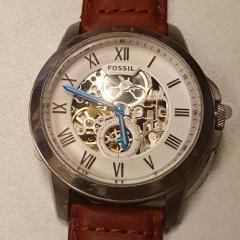-
Recently Browsing
- No registered users viewing this page.
-
Topics
-
Posts
-
For those who are, curious I broke out the macro lens and took a few shots. I'm attaching four of them: Image 1 is from the watchmaker's side and generally shows the problem area. Image 2 is a detail view of the offending dial foot hole (called out with the green circle), the tip of the offending screw (orange arrow) and the blue line indicates the approximate position of what's left of the head of the screw (determined by using an oiler as a feeler gauge to transfer that measurement to the visible portion of the plate.) Image 3 is looking down the screw hole you can see the head of the broken screw at the bottom. Image 4 is the same, but with less contrast to give a better appreciation of the condition of that end of the screw. I can almost convince myself that I can see the remains of the screw slot in the head, but I have to use alot of imagination in that exercise. Heard and understood. There does appear to be a steel locating pin that can be seen in the lower, right center of Image 1 (right "above" the oval shaped slot that is to the left of where the pinion/clutch parts of the keyless works nestle into the plate.) As I don't see a way to remove that I'd have to keep it out of the solution and have even contemplated dropping a little paraffin on it to give it a "rain coat" of sorts. As I missed that before I did the closeup photos, I feel that I'm going to be looking at this plate in much greater detail to see if there anything else I might have missed. The screw assortments seem like a good acquisition. The eBay seller who has the donor movements I was looking at never replied so I may just take a chance and get one of those as well a screw assortment. They do seem like they'd be handy. I have to confess that the idea of fabricating the needed screws appears to some deep part of my soul, I also have to confess that I do not yet have either the equipment, or the skill to use it. Perhaps one day, but that day has not arrived (and I have alot of pricey bits and bobs that I will likely need to get along the way.) I thought about this, but the dial foot screw doesn't seem to be wide enough to get the thing out if I could advance it into the hole. I suppose that I could try and take it out in pieces (advance it as far as it will go, get in there with some sort of saw, take a piece off, walk it forward again, take another piece, etc) but that seems like alot of risk to the main plate. I need to examine the other screw to ensure it doesn't have a shoulder or something that would prevent me from doing something like that. However, all that said, I've been unable to get the thing to move at all. In general, this whole piece feels like someone had it before me, did a bad job of working on it and ultimately just bunged it all back together in a haphazard way and passed it on to be someone else's problem.
-
By luiazazrambo · Posted
Bulova Accutron 2181 - had an open coil I managed to bring it back into life. Longines 9L - not serviced just pics Eterna-Matic Centenaire "61" - 1438U - not serviced just pics. Longines Cal 431 - not serviced just pics Lemania Cal 4650 - not serviced, just pics. Risieres Felsa 690 - not serviced, just pics. Felca Cal ETA 1080 - not serviced, just pics. -
By watchweasol · Posted
attached is the tech /parts sheet. . Can one ask how come it’s full of water. After being told that the waterproofing was not guaranteed. Problem being electronics don’t mix especially withe the power source being attached. You may be lucky but I should look out for a replacement movement or working donor to rob the movement from. C720.pdf -
By JeremyLaurenson · Posted
I thought this may be "right" forum to post this. After 7 months out in Switzerland I got my Navitimer back from Breitling. I had sent it off since its 20 years old to have a complete overhaul done... Nothing major wrong, but I did notice this seconds sundial skipping thingy.... $1300 later and 7 months later, I notice the 'skips' are still here unless the chronometer is engaged. I would think this is likely the hand binding up and maybe clearance with the dial, but at any rate Im interested as to whether this is something I should be returning the watch to Breitling for and insisting on being fixed. See below - 1 minute or so of regular running and then 1 minute with the chronograph engaged. -
A friend of mine just gave me an old pocket watch. The case is in very bad condition but the movement itself seems to be in a quite good shape. I can't identify which movement is this, since I have to find a missing winding stem. I attach few photos in a case somebody would be able to give some hints. Thank's folks
-







Recommended Posts
Join the conversation
You can post now and register later. If you have an account, sign in now to post with your account.
Note: Your post will require moderator approval before it will be visible.